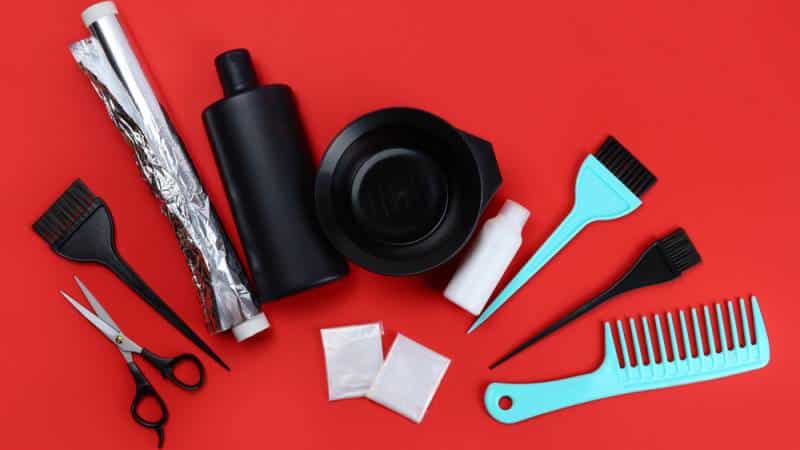It’s a question that’s been asked time and time again: how often can you bleach your hair without damaging it?
The answer, unfortunately, is not as straightforward as one might hope. Depending on your hair type and the strength of the bleach, you may be able to bleach your hair more or less frequently without damaging it.
However, over-bleaching can lead to dryness, breakage, and even loss of color. So how can you tell if you’re over-bleaching your hair? And what can you do to prevent it from happening in the first place? Read on for answers to these questions and more.

The Bleaching Process
Bleaching hair is a two-step process: first, the bleach lifts the color from your hair, and then a toner is used to achieve the desired shade.
The amount of time that the bleach needs to be in contact with your hair will vary depending on how light you want to go. For example, if you have dark hair and you want to go blonde, it will take longer than if you have light hair and you want to go platinum.
The bleach’s strength also affects how long it needs to be left in your hair. A stronger bleach will lift the color faster, but it can also be more damaging to your hair.
The Hair Follicle
To understand why bleaching hair can be damaging, it’s essential to know a little about the hair follicle.
The hair follicle is a small tube-like structure extending from the skin’s surface to the dermis. It’s responsible for growing and nurturing the hair shaft.
The bulb is at the bottom of the hair follicle, where the cells that create new hair are produced. The cells of the bulb are dividing at a rapid rate, which is what helps the hair to grow.
Surrounding the bulb is the cortex, which gives your hair its color, strength, and elasticity. The cortex is made up of long, protein-rich fibers called keratin.
The outermost layer of the hair follicle is the cuticle, which protects the inner layers from damage.
When you bleach your hair, the bleach goes down to the cortex and breaks apart the keratin fibers. This damage can lead to dryness, breakage, and loss of color.

Hair Type
Your hair type plays a role in how well it will tolerate bleaching.
If you have fine hair, it’s more likely to be damaged by bleaching than if you have thick hair. This is because there’s less cortex to protect the hair shaft.
Fine hair is also more likely to absorb color quickly, so you may need to bleach it less often.
If you have coarse hair, on the other hand, it’s less likely to be damaged by bleaching. This is because the cortex is thicker, so there’s more to protect the hair shaft.
Coarse hair may also take longer to absorb color, so you may need to bleach it more often.
Hair Condition
The better condition your hair is in, the more likely it is to withstand bleaching.
If your hair is healthy, it’s more likely to be able to withstand the bleaching process. This is because healthy hair has a strong cortex and a well-hydrated cuticle.
If your hair is damaged, on the other hand, it’s more likely to be affected by bleaching. Damaged hair has a weaker cortex and a dry, brittle cuticle.
How to Prevent Damage
Now that you understand the risks of bleaching your hair, here are some tips on avoiding damage.
Here are a few tips:
- Use a milder bleach: If you’re concerned about damaging your hair, use a bleach kit with a lower bleach concentration.
- Take breaks: If you’re bleaching your hair regularly, take breaks between sessions. This will give your hair a chance to recover from the damage.
- Use a deep conditioner: Apply a deep conditioner to your hair after bleaching it. This will help to hydrate and repair the damage.
- Use a heat protectant: Before you use any heat styling tools, apply a heat protectant to your hair. This will help to prevent further damage.

How Often Can You Bleach Your Hair?
This answer depends on your hair type, the strength of the bleach you’re using, and how healthy your hair is. If you have thick, strong hair, you may be able to bleach it more often than if you have delicate or damaged hair.
However, it’s always best to err on caution and bleach your hair less often than you think you need to. This will help to prevent damage and keep your hair looking its best.
As a hair stylist, I always recommend that my clients wait at least four to six weeks between bleaching sessions. This gives the hair time to recover and helps to prevent damage.
How Often Can You Bleach Your Roots?
Bleaching your roots too often can damage your hair, so it’s best to wait at least six weeks between bleaching sessions.
If you’re bleaching your hair at home, be sure to follow the instructions carefully and use a quality bleach product to avoid damaging your hair. When in doubt, it’s always best to consult a professional stylist to get the best results.
However, if you have thicker hair, you may be able to bleach your roots more often than if you have fine or damaged hair.
What Happens if You Bleach Your Hair Too Often?
If you bleach your hair too often, it can become damaged and brittle—the bleaching process strips away the natural oils that protect your hair, leaving it susceptible to breakage.
Over time, this can lead to thinning hair, split ends, and a dull, lifeless appearance. If you’re concerned about bleaching your hair too often, talk to a professional stylist to find out what bleach frequency is right for you.

How to Take Care of Your Hair Before and After Bleaching
Before you bleach your hair, it’s important to deep condition it to help protect it against damage. Apply a deep conditioner to your hair and leave it on for at least 20 minutes before rinsing.
After you’ve bleached your hair, use a mild shampoo and conditioner to help hydrate and protect your hair. Avoid using hot tools for a few days to give your hair a chance to recover. You may also want to use a leave-in conditioner or oil to help keep your hair hydrated.
Only bleach your hair every 4-6 weeks to avoid damaging it. If you want to touch up your roots more often, use a root concealer or powder instead of bleaching.
The Bottom Line
So, there you have it! Now you know how often you can bleach your hair without damaging it.
Remember, always err on the side of caution and bleached your hair less often than you think you need to. And be sure to deep condition your hair before and after bleaching to help protect it from damage.
Do you have any tips on how to care for bleached hair? Share them in the comments below!


